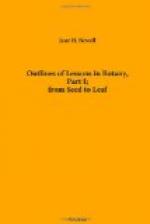The buds are small, flat, and rounded at the apex. They are sheathed by scales, each leaf being covered by a pair, whose edges cohere. The outer pair are brown and are the stipules of the last leaf of the preceding year. The leaves are conduplicate, as in Magnolia, and have the blade bent inwards on the petiole (inflexed). Their shape is very clearly to be seen, and no bud is more interesting in the closeness of its packing. Axillary buds are often found within. The flowers grow high upon the trees and towards the ends of the branches.
The leaf-scars are round with many dots. The scar of the stipules is a continuous line around the stem, as in Magnolia.
CHERRY (Prunus Cerasus).
The leaf-buds are terminal, or in the axils of the upper leaves of the preceding year; the flower buds are axillary. There is but one bud in each axil, and usually two or three flowers in each bud, but the leaves on the twigs are crowded and the flowers therefore appear in clusters. The blossom-buds are larger and more rounded than the leaf-buds.
The buds of the tree develop very easily in the house, and as they are so small they can be better studied in watching them come out, than by attempting to dissect them, unless the scholars are sufficiently advanced to use the microscope easily. It is always bad for a pupil to attempt to describe what he sees but imperfectly. He will be sure to jump at any conclusions which he thinks ought to be correct.
The leaf-scars are semicircular, small and swollen.
The bud-rings are plain. The twigs make a very small growth in a season, so that the leaf-scars and rings make them exceedingly rough.
The flower-cluster scars are small circles, with a dot in the centre, in the leaf-axils. The flowers come before the leaves.
The leaf-arrangement is alternate on the 2/5 plan. The pupils may compare the branching with that of their other specimens.
RED MAPLE (Acer rubrum).
This is a good specimen for the study of accessory buds. There is usually a bud in the axil of each lower scale of the axillary buds, making three side by side. We have already noticed this as occurring sometimes in Lilac. It is habitually the case with the Red Maple. The middle bud, which is smaller and develops later, is a leaf-bud. The others are flower-buds.
The leaf-scars are small, with three dots on each scar. The rings are very plain. The flower-cluster leaves a round scar in the leaf-axil, as in Cherry.
The leaves are opposite and the tree branches freely. The twigs seem to be found just below the bud-rings, as the upper leaf-buds usually develop best and the lower buds are single, containing flowers only.
NORWAY SPRUCE (Picea excelsa).
The buds are terminal, and axillary, from the axils of the leaves of the preceding year, usually from those at the ends of the branchlets. They are covered with brown scales and contain many leaves.




